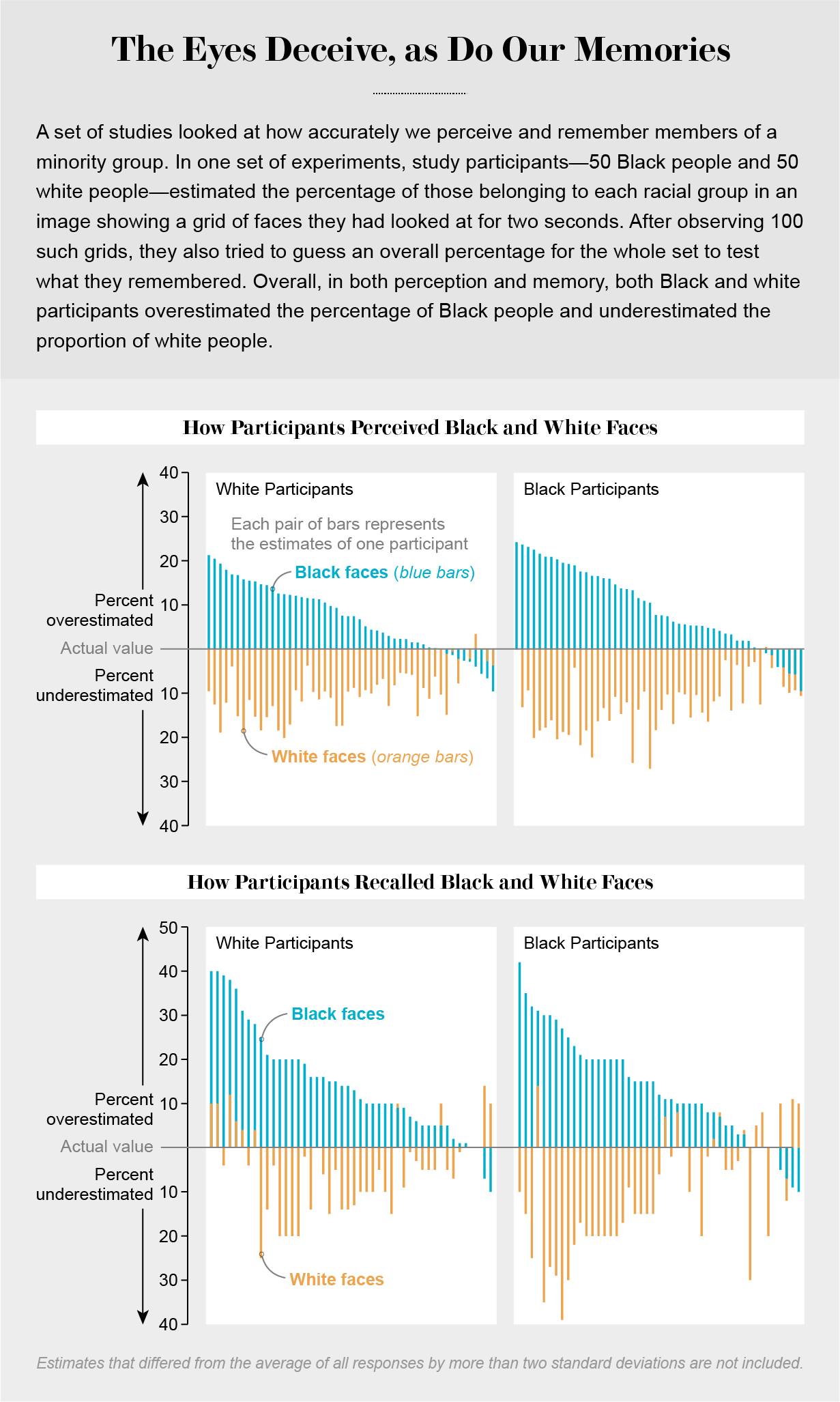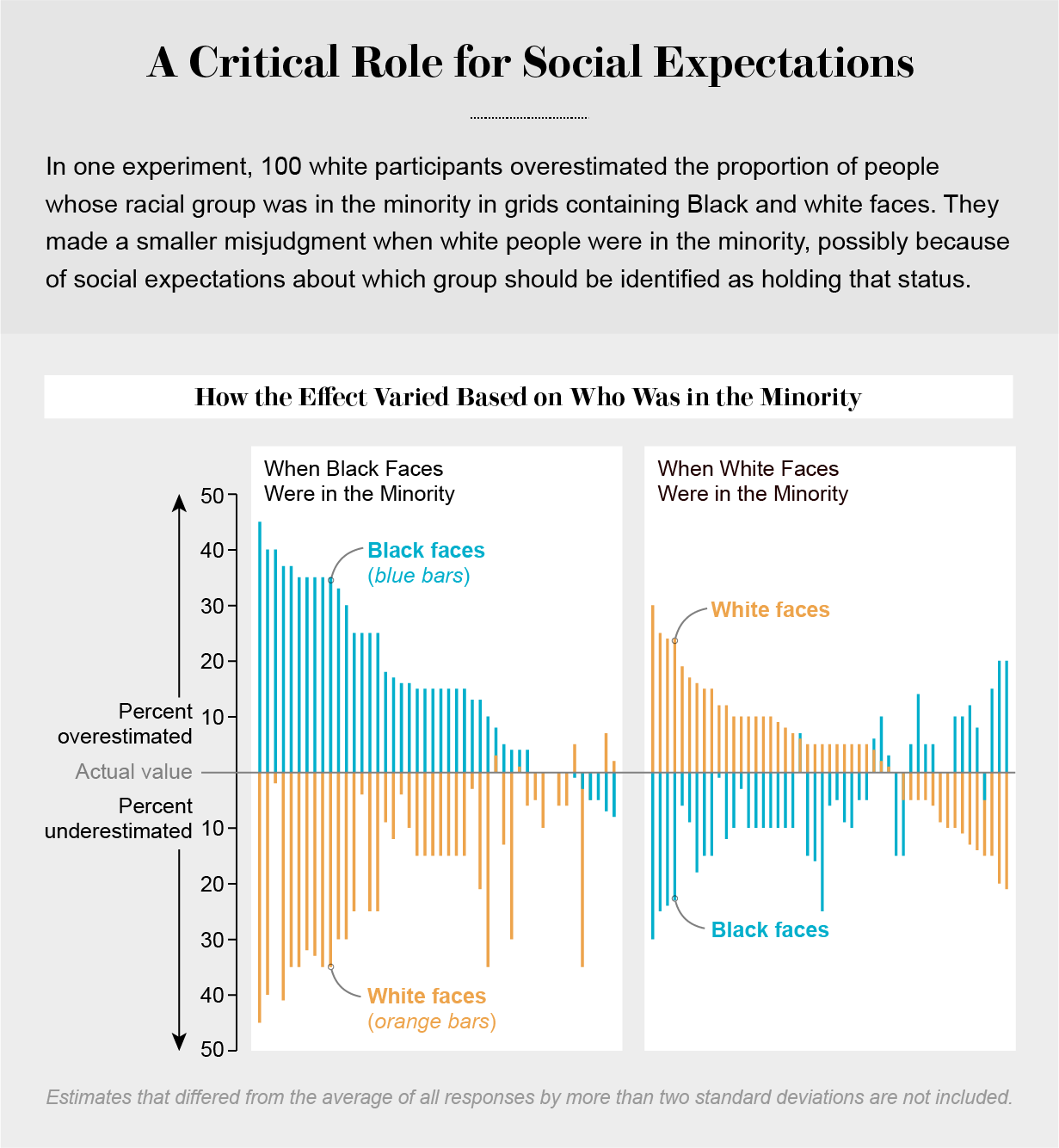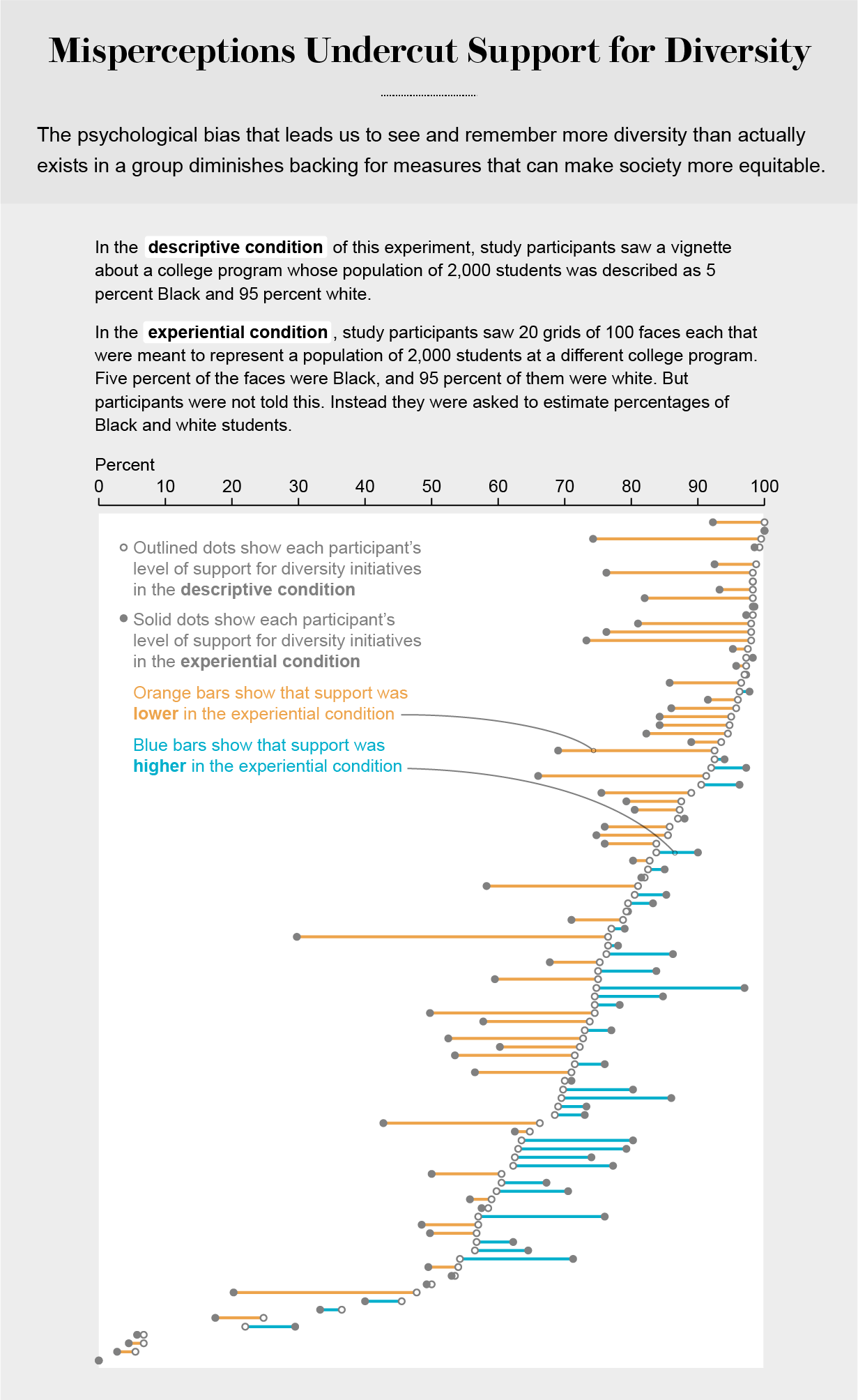People Think Minority Groups Are Bigger Than They Really Are
Our brain is attuned to noticing new things in the busy environment around us. This alertness to novelty means we are apt to overemphasize what holds our attention. When people stand out as different, they stick in our mind because of how much we initially notice their presence—and by how vividly we later recall them.
Our recollection of the unusual carries over into how we think about social groups. A recent survey by YouGov America illustrates the real-life tendency to overrepresent the size of minority populations. Residents of New York City, for example, are a tiny minority of Americans, only 3 percent of the population. But adult respondents to this nationwide survey thought that a whopping 30 percent of Americans live in the Big Apple. The survey also found a consistent overestimation of the size of ethnic and racial minority groups. Respondents on average figured that 41 percent of Americans are Black when the actual proportion is 12 percent.
A study published recently in the Proceedings of the National Academy of Sciences USA demonstrates that extra attention to the uncommon around us may partly explain the bad mental math that contributes to misperceptions about other groups. When people make these overestimates, the study authors found, the result can be an “illusion of diversity” about the presence of minority groups in our social environment. That faulty perception, in turn, can have the paradoxical effect of decreasing support for measures to increase diversity.
Previous research has suggested that negative attitudes toward diversity and inclusion efforts are motivated when a majority group perceives a threat by overestimating minority group size, says Maureen Craig, a social psychologist and an assistant professor at New York University, who was not involved in the new study. Its findings, she says, highlight a cognitive response that comes before the overestimation. People latch onto the unusual before making other judgments about it, such as the size of purportedly “competing” groups. Taking notice of what is uncommon to someone is “a basic cognitive phenomenon in which rare things stand out,” Craig says.
The new study’s first author, Rasha Kardosh, a social psychologist at the Hebrew University of Jerusalem, and her colleagues ran 12 experiments with 942 participants in both the U.S. and Israel. Across all of these studies, 82.6 percent of the participants overestimated the proportion of minority group members.
Some experiments took place at the Hebrew University, where most students speak Hebrew, a minority speak Arabic and culturally based visual signals can sometimes distinguish group members. Student participants were asked to estimate the percentage of Arab students they thought were on campus. At the Hebrew University, 9.28 percent of students were Palestinian Israeli at the time of the study, but the Jewish Israeli students gave their estimate for the group as 31.56 percent, and the Palestinian Israeli students gave an estimate of 35.81 percent. Other students were tested for how quickly they detected images of women wearing either a Muslim or Jewish religious headscarf. They did so more quickly for images of women wearing scarves in the Muslim style.
In the U.S., the researchers had participants look at a screen showing a grid of 100 photographs with faces of Black people and white people in different proportions. Viewers had to estimate the overall percentages of Black and white people present after seeing a set of 20 such grids, each viewed for two seconds.
When 25 percent of the images in the grids were of Black people, white participants estimated the proportion of Black faces to be 43.22 percent, and Black participants put it at 43.36 percent. When 45 percent of the images were of Black faces, white participants estimated the proportion of Black people at 58.85 percent, and Black participants thought it was 56.18 percent.
In other experiments, participants were asked to estimate the proportions of Black and white faces directly after seeing each of a series of grids and to then make the same calculation after having gone through the entire set of 20 grids. In both cases, they overestimated the proportion of Black faces and underestimated the percentage of white faces.
 Credit: Amanda Montañez; Source: “Minority Salience and the Overestimation of Individuals from Minority Groups in Perception and Memory,” by Rasha Kardosh et al., in Proceedings of the National Academy of Sciences USA, Vol. 119, No. 12. Published online March 14, 2022
Credit: Amanda Montañez; Source: “Minority Salience and the Overestimation of Individuals from Minority Groups in Perception and Memory,” by Rasha Kardosh et al., in Proceedings of the National Academy of Sciences USA, Vol. 119, No. 12. Published online March 14, 2022
The researchers also wanted to know whether preexisting expectations about which group should be in the minority would affect the outcome. They showed 100 white participants grids in which 25 percent of the photographed faces were white, making them the minority, and another set in which 25 percent were Black. In both cases, the presence of faces from less common groups was judged to be higher than it really was. Overestimates were higher, though, when images of Black people were in the minority, illustrating the impact of social expectations. “That was a really nice demonstration that you can flip it,” says Craig, referring to the overestimation when white faces were in the minority. That overestimation “is a lot smaller effect, but it is new—I’ve not seen that before.” This finding suggests that everyone has some cognitive bias that leads to overestimations of a numerical minority, she says, going beyond earlier work focused largely on how perceived growth of minority groups affects racial attitudes.

A final set of experiments examined how psychological bias affects support for academic diversity efforts. Participants were shown information about two college programs. In what the researchers called the “experiential” condition, participants viewed 20 grids of 100 photographs, with Black faces making up 5 percent. In what they called the “descriptive” condition, the group simply watched a video that informed viewers that 5 percent of a different college program’s students were Black. After both exercises, participants were asked whether more should be done to increase diversity, rating their opinion on a scale from 0 (for “not at all”) to 100 (“a great extent”).
After viewing the photographic grids in the experiential condition, participants estimated the proportion of Black faces to be 14.75 percent, not 5 percent, while simultaneously underestimating the proportion of white faces as 83.26 percent, not 95 percent. Support for a diversity-improvement program was lower in the experiential condition, with an average score of 71.07, compared with 74.5 in the descriptive condition.
 Credit: Amanda Montañez; Source: “Minority Salience and the Overestimation of Individuals from Minority Groups in Perception and Memory,” by Rasha Kardosh et al., in Proceedings of the National Academy of Sciences USA, Vol. 119, No. 12. Published online March 14, 2022
Credit: Amanda Montañez; Source: “Minority Salience and the Overestimation of Individuals from Minority Groups in Perception and Memory,” by Rasha Kardosh et al., in Proceedings of the National Academy of Sciences USA, Vol. 119, No. 12. Published online March 14, 2022
The researchers also assessed whether existing attitudes among the participants affected their estimates and found no such associations.
If people go with what their intuition tells them about minority representation rather than using actual numbers, doing so could be costly, says Ran Hassin, a cognitive scientist at the Hebrew University and senior author of the study. Relying on impressions instead of evidence, he says, might lead people to be less supportive of policies to enhance minority presence on a campus or in a workplace. The results show that “this is something we all share,” Kardosh adds. “If you think you’re immune, you’re probably not.”
People talk about “being sensitive to the optics” when it comes to diversity efforts in workplaces, says Susan Fiske, a professor of psychology and public affairs at Princeton University, who was not involved in the study but edited it for PNAS. This focus on awareness of optics is “saying that optics are really important,” she says, which is why these results showing that the “optics can be wrong” deserve our attention.






